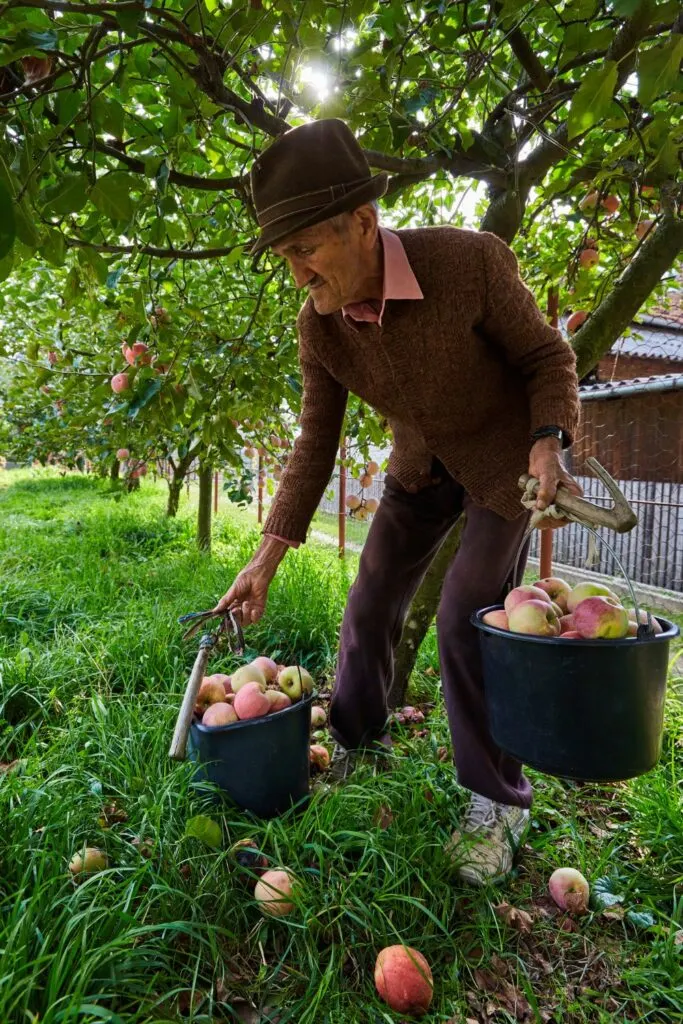Are you looking for a unique way to make money while enjoying the great outdoors? Picking apples might just be the perfect opportunity for you. It’s an engaging, seasonal job that allows you to work outside and connect with nature, all while earning a decent income.

Many apple orchards are often on the lookout for enthusiastic individuals to help during the harvest season.
Apple picking is a temporary job that requires hard work and dedication, but it can be both fun and rewarding. A typical day in the life of an apple picker involves strapping on a picking bag, climbing a ladder, and selecting ripe apples from the trees using a gentle twist-and-pull motion source. Pay is often determined by the amount of fruit collected, so speed and efficiency play a significant role in boosting your potential earnings up to $28 per hour! With a bit of practice, skilled pickers can even make around $250 in a single day, making apple picking an attractive option for those willing to put in the effort source.
No matter your previous experience, apple picking offers a chance to enjoy the crisp autumn air, explore picturesque orchards, and earn some extra money in the process. So why not give it a try and see if this outdoor job is the right fit for you?

Getting Started with Apple Picking
Finding the Right Orchard
To begin your apple picking journey, the first step is to locate the right orchard to work in. Look for orchards with a variety of apple trees and research when the apple picking season starts in your region to ensure you’ll have consistent work. The timing can vary depending on the climate and specific apple varieties grown.
Essential Equipment
When heading out to pick apples, make sure you’re equipped with the necessary tools for a successful and efficient picking experience. Some essential equipment includes:
- Apple picking bag or basket: This will help you carry large quantities of apples with ease while keeping your hands free for picking.
- Comfortable clothing: Dress in layers and wear clothes that can get dirty and protect you from the elements.
- Sturdy footwear: Protect your feet in case you drop any apples, and provide support when walking on uneven ground.
- Gloves: Opt for gloves with a good grip to minimize bruising of the apples and protect your hands from branch scratches.
- Ladder or fruit picker pole: Depending on the height of the apple trees, you may need a ladder or a fruit picker pole to reach higher branches.
Discovering Apple Varieties
There are thousands of apple varieties grown in orchards around the world. It’s important to familiarize yourself with the types of apples you’ll be picking, as this can impact both the picking technique and the payment model (some orchards may pay more for certain varieties). For example, picking larger apples usually results in faster bin filling, as it takes less big ones to full up a container, which could potentially lead to increased earnings.
When picking apples, remember to work from the outside in, as apples on the outer branches tend to ripen first. Then, move closer to the tree center as the season progresses. Finally, always handle apples gently to avoid bruising and pick ones with smooth skin free from nicks, wrinkles, and soft spots to impress the orchard owner.

Picking Techniques and Strategies
Identifying Ripe Apples
When picking apples, it’s essential to know how to identify ripe fruit. Apples on the outer limbs of the tree generally ripen first, so start by picking from the outside of the tree. As the season progresses, move further towards the center of the tree. To determine if an apple is ripe, use a gentle twist-and-pull motion. If the apple is ripe, it should release easily from the tree. Avoid pulling directly outward, which can damage the tree.
Climbing and Ladder Safety
Safety should be a top priority when picking apples. Climbing the tree and using ladders come with some risks, so follow these guidelines:
- Always use a sturdy ladder designed for picking apples.
- When climbing the tree, make sure there are stable branches that can support your weight.
- Keep three points of contact with the ladder at all times (e.g., two feet and one hand).
- Do not overreach while on the ladder; instead, reposition the ladder to a better location.
Using Bags and Bins for Storage
Proper storage is crucial for preserving the quality and freshness of your apple harvest. Here are some tips for using bags and bins for apple storage:
- As you pick apples, twist them off the tree gently without breaking the tips of the branches.
- Use a picking bag with an adjustable strap that can be secured around your waist or shoulder. The bag should have a capacity of approximately 45 pounds of apples.
- When the picking bag is full, climb down from the tree or ladder, and carefully loosen the strings to open the bottom of the bag over a storage bin, allowing the apples to gently spill into it.
- Store the apples in a cool, dark location to preserve their freshness longer.
- Remember to monitor the weather forecast, as rainy conditions may affect the quality of the fruit as well as the work schedule.
These picking techniques and strategies will help you have both a productive and safe apple harvesting experience.

Maximizing Your Income
Improving Your Speed and Efficiency
To make the most money while picking apples, it’s important to improve your speed and efficiency on the job. A skilled worker can pick about 12 boxes a day, and pay is often determined by the amount of apples picked. Here are a few tips to help you get faster:
- Choose big apples: Big apples take about the same amount of time to pick as smaller ones, but you’ll fill bins faster with fewer large ones (source).
- Pick juice apples: Apples used for juice can be picked more quickly than those for eating, as they are bound for processing rather than being sold as fresh fruit (source).
- Start with the outer branches: Apples on the outer limbs of trees ripen first, so start picking from the outside and work your way in (source).
- Twist and pull gently: Use a gentle twist-and-pull motion when picking apples, as ripe ones should release easily with this method (source).
Earning Extra Money in Related Industries
In addition to picking apples, you can earn extra money by exploring opportunities in related industries. Many apple orchards require additional help during the harvest season, so don’t hesitate to inquire about available positions:
- On-site retail: Some orchards have farm stores or stands where they sell apples and other products. If you can work as a cashier or merchandise organizer, you’ll have an opportunity to earn extra cash.
- Processing and packaging: Another way to make money in the apple industry is to help with processing apples for juice and other products or sorting and packaging apples to be sold in bulk.
- Tourism and events: At orchards that offer pick-your-own experiences or host seasonal events, you could work as a customer service representative or event staff, assisting visitors and guiding groups of pickers.
By improving your picking skills and exploring related job opportunities, both men and women, immigrant workers or locals, can maximize their income and make the most of the apple picking season.
Market Dynamics and Profitability
Understanding Wages and Costs
Apple picking involves physical labor and skill, with workers being paid based on the number of boxes picked per day. A skilled worker can pick about 12 boxes or six tons of apples a day, which translates to their wage. The cost of picking apples also depends on factors such as labor availability and seasonal weather conditions.
Aside from labor costs, there are other operational expenses one should consider. These include maintaining the orchard, pest control measures, and transportation expenses.
Analyzing Supply, Demand, and Prices
The fluctuation in supply and demand of apples, along with market competition, directly impacts the prices. Consumer preference for specific apple varieties and seasons also plays a role in pricing strategy. In 2019, the average US per person consumption of apples increased to about 26.3 pounds.
Different sales channels offer various price points for selling apples. For instance, pick-your-own orchards in Minnesota sell many apple varieties for around $1.00 per pound, while pre-picked fruit costs around $1.25 per pound. Wholesale prices also vary, as bulk orders usually have discounted rates.
To increase profitability, understanding the market dynamics and catering to consumer preferences is essential. This can be achieved by offering various sales channels such as pick-your-own, on-farm sales, and farmer’s market sales. Additionally, investing in efficient harvesting methods, popular apple varieties, and effective marketing strategies can significantly impact your return on investment.
Challenges and Solutions
Managing Work-Life Balance
Picking apples can be a demanding job, as one needs to work efficiently to maximize their earnings. Workers typically get paid per 1,000-pound box of apples, and a skilled worker can pick around 12 boxes a day, totaling six tons of apples 1. Balancing work hours with personal life can be a challenge. Having clear boundaries and setting a schedule that allows for enough rest and leisure time is crucial for maintaining a healthy work-life balance.
In order to achieve this balance:
- Set a consistent work schedule: Stick to regular working hours to ensure that you have enough time to unwind and take care of personal matters.
- Prioritize free time and socializing: Plan leisure activities and social events in advance to ensure a fulfilling personal life outside of work.
- Stay organized: Keep track of daily tasks and deadlines to avoid stress and stay on top of your responsibilities.
Addressing Common Health and Safety Concerns
Apple picking can be a physically demanding job, with potential risks to one’s health and safety. Some concerns may be related to:
- Land: Uneven terrain could increase the risk of falls or injuries. Invest in proper footwear with good traction and be cautious while navigating the orchards.
- Wasps: Apple orchards may attract wasps that can sting workers. Be aware of your surroundings and consider wearing protective clothing.
- Waists: Picking apples can strain the waist and back muscles. Incorporate regular stretching and practice proper lifting techniques to minimize any strain.
- Math: Keeping track of the number of boxes picked can be tedious. Develop a system to simplify this task, such as marking bins or using a tally counter.
- Hospital: In case of an injury, it’s important to know the location of the nearest hospital or medical facility.
- Interest: Staying motivated in a physically demanding job can be difficult. Find ways to stay engaged and maintain interest in your work, such as setting daily goals or striving for continuous improvement.
By taking these steps to address common challenges, apple pickers can enjoy a rewarding outdoor job that offers the potential to earn up to $28 an hour, all while enjoying the satisfaction of a job well done.
Regional Considerations
Apple Picking in Different US States
Apple picking as a means of making money varies across different states in the US. In Michigan, apple picking is an essential part of the state’s agricultural sector, offering numerous opportunities during the apple harvest season. Pennsylvania is another state known for its apple production, with several farms hiring seasonal workers to support their operations. Meanwhile, Florida‘s warmer climate is not ideal for growing apples, so apple picking opportunities are generally limited.
It’s important to consider the environment and climate when seeking apple picking jobs. For instance, Central Washington is a popular area for apple growers, while parts of the American Northeast are also prime locations for apple production. Exploring regional differences and opportunities can help maximize earnings from apple picking.
Impact of Seasonal Worker Migration
Seasonal worker migration has a significant impact on the apple-picking industry. As NPR highlighted, apple picking is a labor-intensive job, with some workers, such as Jose Martinez, picking 15,000 pounds of apples per day. The influx of seasonal workers from different backgrounds contributes to a competitive atmosphere in the apple picking industry, which can influence pay and job availability.
Skilled workers who migrate to the US for seasonal work can earn up to $250 in a day by picking apples, provided they maintain a fast pace throughout their workday. This influx of labor not only benefits the farms that rely on apple pickers but also provides valuable income for seasonal workers. However, it’s essential to recognize that this seasonal migration can lead to periods of intense competition for these jobs, making it crucial to apply early and research the regions with the highest demand.
Taking regional considerations into account can help apple pickers navigate the challenges of the industry and maximize their earnings. By understanding the impact of seasonal worker migration and regional differences in apple production, those looking to make money picking apples can better position themselves for success in this demanding field.
Delicious Apple Recipes to Try
In this section, we’ll explore two scrumptious apple recipes that you can try after making money picking apples. These recipes will help you put your apple haul to good use and impress your family and friends.
Making Homemade Apple Pie
A classic favorite, homemade apple pie, is the perfect dessert to showcase your freshly picked apples. Here’s a simple recipe to create a delicious apple pie:
- Preheat your oven to 425°F (220°C).
- Prepare a basic pie crust for a 9-inch pie plate.
- Peel, core, and slice 6-7 apples (Granny Smith or a mix of sweet and tart apples work well).
- In a large bowl, mix the sliced apples with 1/2 cup granulated sugar, 1/4 cup brown sugar, 1/4 cup all-purpose flour, 1 teaspoon cinnamon, 1/4 teaspoon nutmeg, and a pinch of salt.
- Place the apple mixture into the pie crust, and dot with 2 tablespoons of butter cut into small pieces.
- Add the top crust to the pie, seal the edges, and cut a few vents to allow steam to escape.
- Brush the top with a beaten egg for a golden finish, and optionally sprinkle with sugar.
- Bake for 45-50 minutes, or until the crust is golden brown and the apples are tender.
Creating Tasty Apple Butter
Apple butter is a delicious, versatile treat that you can spread on toast, use as a topping for pancakes, or stir into yogurt. Try your hand at this easy-to-make recipe:
- Peel, core, and chop 4 pounds of apples (a mix of sweet and tart apples works best).
- In a large pot or slow cooker, combine the chopped apples with 2 cups granulated sugar, 1 cup brown sugar, 1/4 cup apple cider vinegar, 2 teaspoons cinnamon, 1/2 teaspoon ground cloves, and a pinch of salt.
- Cook the mixture on low heat for 8-10 hours, stirring occasionally. The apples should become very soft and the mixture should thicken.
- Use an immersion blender or blend in batches to puree the apple mixture until smooth.
- Transfer the apple butter to clean jars or containers, and store in the refrigerator for up to 3 weeks, or freeze for longer storage.
These delicious apple recipes not only help you enjoy the fruits of your labor (pun intended) but are also perfect for sharing with others. Happy cooking!
